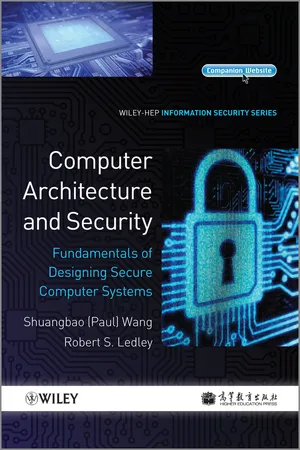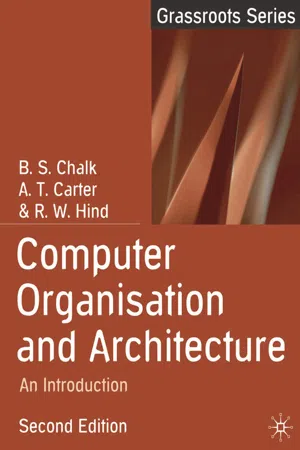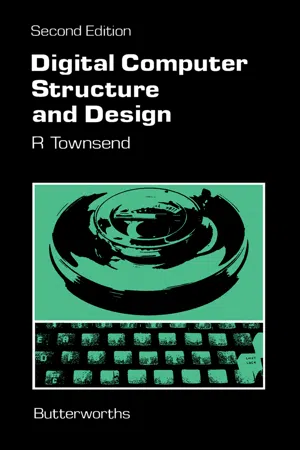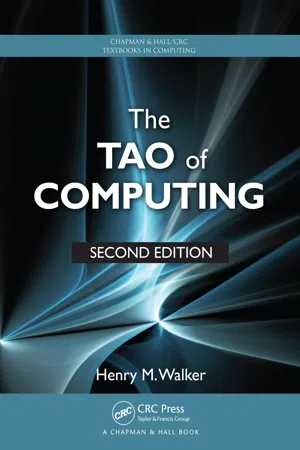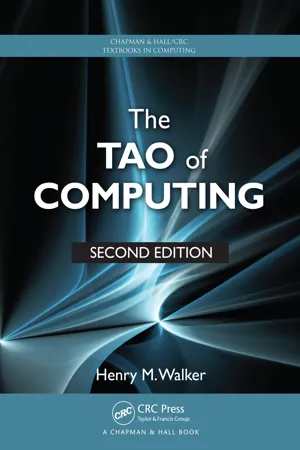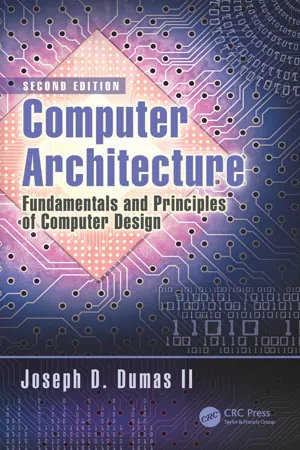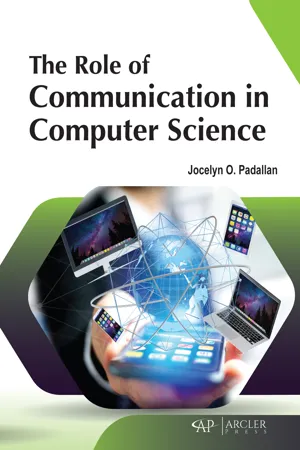Computer Science
Computer Memory
Computer memory refers to the physical devices used to store data and instructions for processing in a computer. It comes in various forms such as RAM (random access memory) and ROM (read-only memory), and is essential for the functioning of a computer system. Memory allows for the temporary storage and retrieval of data and instructions during processing.
Written by Perlego with AI-assistance
Related key terms
1 of 5
11 Key excerpts on "Computer Memory"
- eBook - PDF
- A Thorne(Author)
- 2025(Publication Date)
- Macmillan(Publisher)
Primary memory (system memory or main memory) Volatile memory Non-volatile memory This is short-term memory that loses its contents when the computer is switched off. This is long-term memory that keeps its contents even when there is no power supply. RAM (Random Access Memory ) • A RAM chip is an electronic data storage medium. The CPU writes and rewrites the information stored in each RAM chip. • Data and program code that the CPU needs for an activity are loaded temporarily in RAM. • The more RAM a computer has, the faster it can perform. • The capacity of RAM is measured in MB or GB. • The speed of RAM is measured in MHz or GHz. Cache (Pronounced ‘cash’; rhymes with ‘flash’) • Cache memory is a small piece of volatile memory linked to the CPU. • It stores data and program code that are used often. This enables high-speed access to the CPU. • There is memory cache (or Static RAM), and disk cache (or Dynamic RAM). ROM (Read Only Memory) • ROM is used to store permanent information needed to operate the system (e.g. starting up the computer). • An essential ROM chip is the BIOS (Basic Input/ Output) for setting up a computer. • It is not easy to erase the contents of ROM chips. Flash (USB memory; ‘data stick’) • Flash memory is a memory chip for storing data so that it can be transferred from a PC to another device, or the other way around. • It can be used to make a copy or backup of information. • You can erase the information on a flash drive. Figure 1.3.6: Different types of primary memory Memory is also important in the activities of the CPU . The CPU works with the input, output and storage devices. It processes information and carries out instructions from the computer’s software and hardware. The CPU fetches a program instruction from the main memory, carries it out and stores the results in the memory. It then fetches the next instruction. This all happens very fast. The control unit in the CPU controls all its activity. - eBook - ePub
Computer Architecture and Security
Fundamentals of Designing Secure Computer Systems
- Shuangbao Paul Wang, Robert S. Ledley(Authors)
- 2012(Publication Date)
- Wiley(Publisher)
Chapter 3 Computer Memory and StorageIn this chapter, we will progress from how to design a one bit memory to how a large memory module is organized and connected through the memory interface. We will also study different memories including external memory and what are the main advantages for each of them. This chapter ends with some security issues about memory and how to secure data stored in memory.Memory is the key component in computer systems. It determines greatly the speed of a computer system. Two of the most important parameters of memory are the speed and the cost. The “access time” of Computer Memory includes memory read time and memory write time. In order to make memory fast, we usually use the fastest memory circuits and add a considerable number of circuits to the main memory. This makes the memory expensive. To reduce the memory cost, data and programs not immediately needed by the system are normally stored in less expensive secondary memory such as hard drives. Secondary memory is also called storage. Data stored in the storage are brought into the main memory as the CPU needs them.3.1 A One Bit Memory Circuit
People use flash memory to store photos and documents. However fewer people have asked how data on the flash memory are stored, what a single memory unit looks like and why it can hold data without need for a battery?First let us look at the Computer Memory. A memory is a device that data can be written in and read out. Moreover, data need to be kept (stored) even after the writing/reading action is completed.Figure 3.1 shows one of Edison's great inventions, a light bulb. When we turn on the switch K, the light is on and will stay on. When we turn off the switch, the light is off and will stay off until it is turned on again next time. Now we see that the bulb and switch device can remember.Figure 3.1 A light bulb and a switchWe would not use this device to build a computer since every action (write) needs human interaction. A transistor can be used as an electronic switch. Figure 3.2 - eBook - PDF
Computer Organisation and Architecture
An Introduction
- B.S. Chalk, Antony Carter, Robert Hind(Authors)
- 2017(Publication Date)
- Red Globe Press(Publisher)
Main memory provides the largest internal storage area that can be directly accessed by the CPU, having a typical storage capacity of between 128 MBytes and 512 MBytes in a PC. There may be more in PCs being used as network servers and in many mainframe computer systems. To reduce cost, main memory is normally implemented using Dynamic Random Access Memory (DRAM) chips (see Section 6.3). Because DRAM operates at around one-tenth of the speed of CPU logic, it tends to act as a bottleneck, reducing the rate at which the processor can fetch and execute instructions. To compensate for this, many systems include a small high-speed cache memory. Cache memory sits between the CPU and main memory and is usually implemented using more expensive Static Random Access Memory (SRAM) technology (see Section 6.3). This transparent memory is used for storing frequently used program segments. Each time the CPU requests an instruction or data word, the cache is always checked first. If the information is found in the cache, a ‘hit’ occurs and the instruction or data word is rapidly retrieved and passed directly to the processor. If the information is not in the cache, a ‘miss’ takes place and the slower memory is accessed instead. Once the data has been retrieved from main memory after a miss it is placed in cache memory in case it will be required again in the near future. Memory that is not directly accessible by the CPU is called external memory and includes secondary storage devices such as magnetic disks, tapes and optical storage devices, such as CD-ROMs and DVDs. These devices, which must be accessed through input–output (I/O) interface circuits, are the slowest components in the memory hierarchy. They provide a high-capacity storage area for programs and data not immediately required by the processor. - eBook - PDF
- Alvin Albuero De Luna(Author)
- 2023(Publication Date)
- Arcler Press(Publisher)
Figure 3.1. Computing system. Source: https://kilthub.cmu.edu/articles/journal_contribution/Memory_Sys- tems/6469010/1. In computing, the memory system is a data storage system through which information may be accessed and modified by the CPU (or processors). When a computing system is operating, the processor interprets information from the memory system, executes calculation on the information, and starts writing the customized information back into the memory system – such process is continuously repeated until all required calculation is executed on all the required information (Figure 3.2) (Olivera, 2000; Bivens et al., 2010). Computer Memory Systems 95 Figure 3.2. Hierarchical representation of memory systems of computer. Source: https://www.tutorialandexample.com/computer-memory. 3.1.1. Basic Concepts and Metrics The entire quantity of data that a memory system may keep is its capacity. A distinct address is assigned to each item of data kept in the memory system. The initial item of data, for instance, has an address of zero, while the last piece has an address of capacity-1. The address space of the memory system refers to the whole range of potential addresses, which ranges from zero to capacity-1. As a result, to retrieve specific information from the memory system, the processor should provide the memory system with its address (Hollingshead, 1998; Xia et al., 2015). Many significant metrics define the execution of a memory system: (i) bandwidth; (ii) parallelism; and (iii) latency are all factors to consider. Lower latency, higher bandwidth, and higher parallelism are all characteristics of a good performance memory system. The length of time required for the CPU to acquire information from the memory system is referred to as latency. The pace at which the CPU may receive information from the memory system is measured in bandwidth, also referred to as throughput. - eBook - PDF
- R. Townsend(Author)
- 2014(Publication Date)
- Butterworth-Heinemann(Publisher)
Chapter 7 Computer Memories It is impracticable to give more than a review of the field of memories, because of the very rapid rate of technological change, and the range and complexity of the subject. The aim can only be to give an introduction to the various types of memories in use at present or perhaps in the near future. The only way to keep up-to-date in this area is by continuously reading trade literature to know what is available and in which direction developments are leading. Semiconductor memories are now sold as chips with their performance specifications, but little detailed information can be found about the way they are designed, which is highly specialised, and is the private know-how of manufacturers. The memory might well be regarded as the most important component of a computer. As a consequence of improvements in microcircuitry the cost of the central processing logic is being progres-sively reduced, so that the aim is to cram as much memory capacity into the smallest space, and with the shortest access time to stored data, and also at the lowest cost per bit. The needs of memory users have applied continual pressure to development, which leads to continuing revolutionary changes in technology. Out of the welter of different types of memories, several successful technologies have emerged. The speed and organisation of a memory can profoundly affect the fundamental arrangement of the processor, and therefore the way in which it is fitted into the rest of the processor organisation. It is there-fore essential to have a conceptual understanding of the various types and properties of memories. The subject is suffused with jargon and acronyms which are constantly changing with new developments. The following terminology may elucidate some of the language. Terminology Word A group of bits. These may represent a binary or coded decimal number, binary coded symbols for letters or other data which has been 144 - eBook - PDF
- Henry M. Walker(Author)
- 2012(Publication Date)
- Chapman and Hall/CRC(Publisher)
Where Are Programs and Data Stored? ◾ 99 eliminating RAM would mean a computer could not function at all (except perhaps for the simplest jobs), and eliminating the cache memory would make processing very slow. Let us examine these two points in more detail. We have noted that ROM can store programs or data, but that material cannot be changed. Thus, when you type information into a computer, the data cannot be stored in ROM—your typing created data that were not present earlier, and ROM only stores infor-mation that was specified when the ROM was manufactured or shipped. Without ROM, therefore, your typing would have to go to a disk or to a CPU register—there would be no other place to store new information. However, a disk is quite slow for data storage and retrieval, and CPUs can store very little data in their registers. To clarify these constraints further, consider the display of a window on a computer monitor. As noted in Chapter 3, a single image likely requires several thousand bytes of material, and that is more informa-tion than can be stored in the few CPU registers. Thus, all display of material would have to rely on disk material—even just to change the pointer for a mouse. The resulting perfor-mance of the computer would be completely unacceptable. Altogether, ROM can be very helpful to store a few specialized programs, but programs also need data that can be updated, and updated data cannot be stored in ROM. Instead the main memory (RAM) is essential for the ongoing needs of programs with their updating of data. In contrast, processing could proceed if the cache memory were eliminated; programs could run, data could be stored and updated, and information could be displayed on a monitor. However, the performance of the computer likely would be unacceptably slow without cache. For example, Table 4.1 suggests that the cache memory is roughly about five times faster than the main memory for general processing. - Dogan Ibrahim(Author)
- 2002(Publication Date)
- Newnes(Publisher)
The microprocessor consists of a central processing unit (CPU) and the control unit (CU). The CPU is the brain of a microprocessor and is where all of the arithmetic and logical operations are performed. The control unit controls the internal opera-tions of the microprocessor and sends out control signals to other parts of the microprocessor to carry out the required instructions. 1 2 Microcontroller-based Temperature Monitoring and Control Memory is an important part of a microcomputer system. Depending upon the application, we can classify memories into two groups: program memory and data memory. Program memory stores all the program code and this memory is usually non-volatile, i.e. data is not lost after the removal of power. Data memory is where the temporary user data is stored during the various arithmetic and logical operations. Data memories are usually volatile. There are basically five types of memories as summarized below. RAM RAM means Random Access Memory. It is a general purpose memory which usu-ally stores user data. RAM is volatile, i.e. data is lost after the removal of power. Most microcontrollers have some amount of internal RAM. Generally, 256 bytes is a common amount, although some microcontrollers have more, some less. ROM ROM is Read Only Memory. This type of memory usually holds program or fixed user data. ROM memories are programmed at the factory and their contents cannot be changed by the user. ROM memories are only useful if you have developed a program and wish to order several thousands copies of it. EPROM EPROM is Erasable Programmable Read Only Memory. This is similar to ROM but the EPROM can be programmed using a suitable programming device. EPROM memories have a small clear window on the chip where the data can be erased under an UV light. Many development versions of microcontrollers are manufactured with EPROM memories where the user program is usually stored.- eBook - ePub
- Henry M. Walker(Author)
- 2012(Publication Date)
- Chapman and Hall/CRC(Publisher)
CHAPTER 4 Where Are Programs and Data Stored?A S WITH THE REPRESENTATION of data, many applications make the details of program and data storage transparent to users as they run programs. Thus, when running a program, we rarely worry about where the program was stored, how the main memory is allocated for our work, or how data move into the main memory or the CPU. Similarly, when we work with a file from a word processor, spreadsheet, database, or Web browser, we normally do not think much about where on the disk the material is stored, how we open a file, or how the machine knows where to look for it. However, it is natural to wonder how these materials are stored and retrieved. Sometimes a basic understanding of such matters can guide us in getting work done efficiently. This chapter reviews some basics of program storage and data storage and considers how we can use this knowledge in our regular use of computers.What are the types of memory?
Chapter 1 began an answer to this question by describing basic functions of the CPU and its registers, cache memory, main memory, and I/O devices—all connected by a bus. Addressing this question here allows us to consider four additional elements of a computer’s memory:- Types of main memory (RAM and ROM)
- Transitory versus permanent memory
- Files and their organization
- Virtual memory and its relationship to files and main memory
When we are finished, we will have the hierarchical view of computer storage that is shown in Figure 4.1 . (Although Figure 4.1 serves as a nice summary to this section of the chapter, you may have to keep reading to learn what all of the terms in the figure mean; please be patient as you read ahead!)FIGURE 4.1 Hierarchical view of computer storage (rectangles not proportional to actual size).Types of main memory
As we begin our consideration of computer storage, we need to consider a computer’s main memory a bit more carefully. When considering the main memory, most of it, called random access memory (RAM), functions as described in Chapter 1 - eBook - PDF
Computer Architecture
Fundamentals and Principles of Computer Design, Second Edition
- Joseph D. Dumas II(Author)
- 2016(Publication Date)
- CRC Press(Publisher)
2.1.2 Characteristics of real memory devices Several types of memory devices are used in modern computer systems. The most popular types of memory are semiconductor chips (integrated circuits) and magnetic and optical media. There are several subtypes using each of these technologies, and each of these has some of the advan-tages mentioned in the previous section but also some disadvantages. As potential designers or at least users of computer systems, we need to be familiar with these memory technologies. Semiconductor memories in general possess the advantage of speed. This is why the main memory space of virtually all modern computers is populated exclusively with semiconductor devices, and magnetic and optical devices are relegated to the role of secondary or tertiary (backup) storage. The CPU is built using semiconductor technology, and only a sim-ilar memory technology can keep up with processor speeds. In fact, not all semiconductor memories can operate at the full speed of most modern CPUs; this is why the vast majority of semiconductor main memory sys-tems have an associated cache memory (see Section 2.4) made up of the very fastest memory devices. 57 Chapter two: Computer Memory systems The semiconductor memory technology with the highest information density is dynamic random access memory (DRAM). For this reason, because it is read/write memory, and because it has a relatively low cost per giga-byte, DRAM is used for the bulk of main memory in most computer sys-tems. A DRAM device consists of a large array of capacitors (electrical devices capable of storing a charge). A charged capacitor is interpreted as storing a binary 1, and an uncharged capacitor indicates binary 0. Unfortunately, the capacitors in a DRAM device will discharge, or leak, over time; thus, to be able to continue to distinguish the 1s from the 0s and avoid losing stored information, the information must periodically be read and then rewritten. - Jocelyn O. Padallan(Author)
- 2023(Publication Date)
- Arcler Press(Publisher)
COMMUNICATION IN Computer Memory SYSTEMS 4 CONTENTS 4.1. Introduction .................................................................................... 130 4.2. Memory Hierarchy.......................................................................... 133 4.3. Handling the Memory Hierarchy .................................................... 136 4.4. Caches............................................................................................ 141 4.5. Main Memory ................................................................................. 148 4.6. Future and Current Research Problems ........................................... 154 References ............................................................................................. 159 CHAPTER The Role of Communication in Computer Science 130 4.1. INTRODUCTION A computer system is made up of three basic parts, as depicted in Figure 4.1: (i) To execute operations on data, units of calculation are used (Processors, for example, as we saw in the previous knowledge), (ii) storage (or memory) devices that retain data to be archived or processed, (iii) Communication units that transmit data between storage and compute units (Adrianson & Hjelmquist, 1993). Typically, the memory/storage units fall into two categories: (i) the memory system serves as a working storage space for the data that has been processed via running applications, and (ii) the backup storage system, such as a hard disk, that serves as secondary storage, permanently keeping data for a longer period. This chapter would concentrate on the communication of Computer Memory systems (Hollingshead & Brandon, 2003). Figure 4.1. Computing system. Source: https://kilthub.cmu.edu/articles/journal_contribution/Memory_Sys- tems/6469010/1. The memory system is a data storage system from which the processor may update and retrieve data.- eBook - ePub
Computer Architecture
Fundamentals and Principles of Computer Design, Second Edition
- Joseph D. Dumas II(Author)
- 2016(Publication Date)
- CRC Press(Publisher)
Several types of memory devices are used in modern computer systems. The most popular types of memory are semiconductor chips (integrated circuits) and magnetic and optical media. There are several subtypes using each of these technologies, and each of these has some of the advantages mentioned in the previous section but also some disadvantages. As potential designers or at least users of computer systems, we need to be familiar with these memory technologies.Semiconductor memories in general possess the advantage of speed. This is why the main memory space of virtually all modern computers is populated exclusively with semiconductor devices, and magnetic and optical devices are relegated to the role of secondary or tertiary (backup) storage. The CPU is built using semiconductor technology, and only a similar memory technology can keep up with processor speeds. In fact, not all semiconductor memories can operate at the full speed of most modern CPUs; this is why the vast majority of semiconductor main memory systems have an associated cache memory (see Section 2.4 ) made up of the very fastest memory devices.The semiconductor memory technology with the highest information density is dynamic random access memory (DRAM). For this reason, because it is read/write memory, and because it has a relatively low cost per gigabyte, DRAM is used for the bulk of main memory in most computer systems. A DRAM device consists of a large array of capacitors (electrical devices capable of storing a charge). A charged capacitor is interpreted as storing a binary 1, and an uncharged capacitor indicates binary 0. Unfortunately, the capacitors in a DRAM device will discharge, or leak, over time; thus, to be able to continue to distinguish the 1s from the 0s and avoid losing stored information, the information must periodically be read and then rewritten. This process is called dynamic RAM refresh
Index pages curate the most relevant extracts from our library of academic textbooks. They’ve been created using an in-house natural language model (NLM), each adding context and meaning to key research topics.

